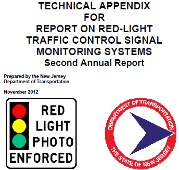Article from: www.thenewspaper.com/news/39/3960.asp
11/28/2012
New Jersey DOT Documents Accident Severity Spike with Red Light Cameras
Accidents become more frequent and more severe one year after red light cameras installed according to the New Jersey Department of Transportation.
 Traffic accident injuries spiked at the intersections where red light cameras were installed in New Jersey, according to a report released Monday by the state Department of Transportation (NJDOT). Under the state law that authorized photo ticketing program in 2008, NJDOT officials must closely monitor the 25 municipalities and 83 intersections using automated ticketing machines. The department's second annual report found the total number of accidents at these intersections increased a statistically insignificant amount one year after the devices were installed -- from 577 before the devices were installed to 582 collisions with ticketing in place. The number of rear end collisions increased a significant 20 percent.
Traffic accident injuries spiked at the intersections where red light cameras were installed in New Jersey, according to a report released Monday by the state Department of Transportation (NJDOT). Under the state law that authorized photo ticketing program in 2008, NJDOT officials must closely monitor the 25 municipalities and 83 intersections using automated ticketing machines. The department's second annual report found the total number of accidents at these intersections increased a statistically insignificant amount one year after the devices were installed -- from 577 before the devices were installed to 582 collisions with ticketing in place. The number of rear end collisions increased a significant 20 percent.
"National reports of RLR programs have generally shown a slight to moderate rise in same-direction crashes due to sudden stops by motorists knowing of the presence of RLR cameras," the NJDOT report explained.
NJDOT officials attempted to paint the program in the most positive light possible. The report claimed the right-angle crashes were "more severe" than rear end collisions, implying the cameras may have provided a modest safety benefit. The actual data suggest the opposite is true. Before cameras were installed, there were no accidents at the monitored intersections serious enough to merit an "A" rating, which generally means a crash victim was admitted at a hospital for treatment of a disabling injury. Once ticketing commenced, the only "A" accident recorded was a rear end collision -- not an angle collision -- at the intersection of Blackwood‐Clementon Road and Cherrywood Drive in Gloucester Township.
The next level of severity, "B," is applied when victims suffer contusions, large lacerations or other visible injuries. Prior to camera use, there was one rear end and one angle accident meriting a "B" rating. After cameras installed, these figures shot up to 5 angle and 4 rear end "B" accidents. The only category seeing an accident reduction at the photo enforced locations were angle collisions that produced minor, property-damage-only collisions. Despite the mediocre results, NJDOT was not ready to call the program a failure.
"The data are still too limited to draw any definitive conclusions about the pilot program at this time," the report explained. "The department therefore recommends continued data collection and monitoring of RLR program intersections."
Another 37 cities and towns throughout New Jersey have lined up to get in on the red light camera pilot project, but state Senator Michael J. Doherty (R-Washington Township) says it is time to pull the plug.
"If the legislature does not move to immediately terminate the pilot program in light of the new data confirming that cameras make intersections more dangerous, that will be proof positive that the real purpose of red light cameras is to give government another way to reach into your pocket through tickets and fines," Doherty said in a statement.
Photo ticketing has a history of controversy in the Garden State. Governor Chris Christie (R) last month reversed course and said he was open to working with lawmakers who want to end the pilot project and re-instate New Jersey's prohibition on automated ticketing machines. In 1992, the US Department of Transportation offered a grant to the state to run speed cameras on state highways. As word spread, the public became so outraged that the state Assembly voted 74-1 in favor of the camera ban. Fifteen years later, heavy lobbying by the photo enforcement industry wore down the legislature's resistance and the current pilot project was authorized.
A copy of the report summary is available in a 300k PDF file at the source link below.
Source: Report on Red Light Traffic Control Monitoring Systems (New Jersey Department of Transportation, 11/27/2012)
Permanent Link for this item
Return to Front Page
 Traffic accident injuries spiked at the intersections where red light cameras were installed in New Jersey, according to a report released Monday by the state Department of Transportation (NJDOT). Under the state law that authorized photo ticketing program in 2008, NJDOT officials must closely monitor the 25 municipalities and 83 intersections using automated ticketing machines. The department's second annual report found the total number of accidents at these intersections increased a statistically insignificant amount one year after the devices were installed -- from 577 before the devices were installed to 582 collisions with ticketing in place. The number of rear end collisions increased a significant 20 percent.
Traffic accident injuries spiked at the intersections where red light cameras were installed in New Jersey, according to a report released Monday by the state Department of Transportation (NJDOT). Under the state law that authorized photo ticketing program in 2008, NJDOT officials must closely monitor the 25 municipalities and 83 intersections using automated ticketing machines. The department's second annual report found the total number of accidents at these intersections increased a statistically insignificant amount one year after the devices were installed -- from 577 before the devices were installed to 582 collisions with ticketing in place. The number of rear end collisions increased a significant 20 percent.